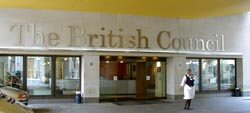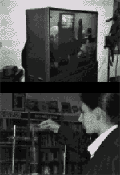Home | About the
Space Science Team | Before | During
| After | Student
Presentations | Visual Tour
Publications | More
Links and Resources | Site Map
Publications
Kolecki, Joseph, and Ruth Petersen, "Real World" Connections Through Videoconferences, NASA/TM 2001-211300, download at http://gltrs.grc.nasa.gov/cgi-bin/GLTRS/browse.pl?2001/TM-2001-211300.html
British Council Science Education Newsletter Publications

Ruth Petersen | Eric AlboneTechnology Connects Science Students to the "Real World"
Ruth Petersen
The British Council Science Education Newsletter 153, March 2001In 1998, Eric Albone, Clifton Scientific Trust, published an article called Science Education for the Real World: A Challenge to be Addressed. According to Albone, the challenge includes concerns that 20th Century school science did not sufficiently engage the imagination and enthusiasm of young people. Students often lack motivation because they see no connection between their schoolwork and real life. Many times students view their assignments as "busy work," never evaluated, never used, never seen by anyone other than the classroom teacher.
The Glenn LTP team believes that the use of technology--videoconferencing and the Internet--and interactions with experts can help motivate science students by providing learning experiences that are similar to the contexts in which the results of learning will be applied. Students can gather resources from the Web, communicate with team members and experts through e-mail as they work on problem-solving activities, and begin to understand the thought processes of experts in the research community through videoconferencing connections. Students admit that knowing that experts might see their work is a great motivator!
During the 2000-2001 school year, the Glenn LTP team has begun participation in several efforts to connect students working on problem-solving activities to NASA scientists through the use of technology. We are honored to be working with Holy Cross School again in July 2001 on one such initiative.
In Ohio, NASA scientists observe an experiment in progress (top), while in the U.K., a student conducts the experiment.
Japan 2001
Glenn Research Center has been asked to participate in an aeronautical engineering project in the Japan 2001 Science, Creativity and the Young Mind Workshop organized by the Clifton Scientific Trust and hosted by the University of Bristol. During the July event, 60 young people from the UK and Japan will work together in small groups on genuine science/engineering related projects. Specialists in such fields as archeology, chemistry, and environmental science will guide the student teams. One team will be led by NASA researchers and assisted by students in a sister school in Cleveland, Ohio. Specifically,
· Before the workshop, a pre-conference activity posted from the Glenn LTP web site will present a quest for background information that will be used to solve a problem in aeronautical engineering. The NASA Glenn Beginner's Guide to Aeronautics (http://www.grc.nasa.gov/WWW/K-12/airplane/index.html) will provide much of the background data.
· On the first day of the workshop, a videoconference between the students and NASA aeronautics specialists will clarify the problem to be solved.
· During the week, the students will correspond with their teammates and the NASA scientists and sister school in Ohio through e-mail.
· At the end of the week, the students will present a solution to the problem to their fellow students and the NASA scientists in a videoconference.More details can be found in an on-line paper by Lawrence Williams of Holy Cross School: www.mirandanet.ac.uk/pubs/williams.htm.
Real World Connections in Ohio
Two similar projects have been proposed to the Glenn LTP team by Ohio educators and are currently being developed:
1. The Center of Science and Industry (COSI) in Toledo has asked NASA Glenn and three other US research facilities to partner with them in bringing problem-based learning experiences to Ohio students. The proposed experiences will include videoconferencing connections with real world experts, an interactive Web site, and a curriculum companion for teachers. The NASA event will be based on research currently being conducted at Glenn to define and develop propulsion, space electrical power, or communications technologies for NASA aerospace missions.
2. In Fairfield, teachers of math and science to the middle grades have submitted a proposal to support for a yearlong project in which students learn about jet propulsion. They will use the Beginner's Guide to Propulsion (http://www.grc.nasa.gov/WWW/K-12/airplane/bgp.html), EngineSim (http://www.grc.nasa.gov/WWW/K-12/airplane/ngnsim.html), and technology (e-mail and videoconferencing) to connect the students to real-world experts at NASA Glenn and a local engine manufacturer. The project will conclude with the development of a model jet engine by each student.
Desktop Videoconferencing
One of Glenn LTP goals for this fiscal year is to provide videoconferencing through H.323 IP desktop videoconferencing technology. The new technology promises to be the wave of the future, allowing distance connections to be established over the Internet at a reduced cost from current technology. In January 2001 we made our first IP connection to students at the Challenger Learning Center in Kenia, Alaska. The interactive session on Exploring Mars was team-taught by a NASA researcher and the Challenger Learning Center Flight Director. Using the IP desktop technology allowed a first videoconference with students in Alaska, where videoconferencing transmission is limited.
Other UK Connections
The Glenn LTP team has been approached about other UK connections. On March 14, 2001, a panel of NASA aerospace researchers will videoconference with Standish Community High School and up to three other schools in the UK in celebration of Britain's National Science Week. Information on each panel member is available online from the description of Meet a NASA Employee Involved in Aerospace Research, which is linked from the Glenn LTP distance learning home page (http://www.grc.nasa.gov/WWW/K-12/CoE/Coemain.html).
Another proposed collaboration with the science teachers at Holy Cross School involves support of a module on space flight. Holy Cross has furnished their space flight curriculum materials to a NASA Glenn researcher, who has made several suggestions for student projects in support of that curriculum. Holy Cross science teachers and students will decide on the student project to be used. NASA Internet sites and connections with NASA researchers through e-mail and videoconferences (if funding is available) will provide the information needed to complete the project.
Summary
Science is the driving force of modern culture. In today's world of high tech, high-speed communications, it is more critical than ever before that we hook and hold students' interest in science, mathematics, and technology. Science education must begin to provide employers with sufficient recruits having appropriate skills. Unless changes are made, the problem will only continue to grow and worsen.
NASA is deeply committed to spreading the unique knowledge that flows from its aeronautics and space research. The Glenn LTP will continue to support this commitment by arranging for NASA scientists to answer students' questions and by giving students glimpses into the world of NASA researchers. We must work to ensure that the division between school and real life does not characterize 21st Century education. Our future depends upon it!
For additional information on Glenn LTP's distance learning program and its first videoconferences with the UK, see the September 2000 Science Education Newsletter and "Real World" Connections Through Videoconferencing-We're Closer Than You Think! in the November 2000 edition of TechTrends (the magazine of the Association for Educational Communications and Technology).For additional information on the Clifton Scientific Trust, visit www.clifton-scientific.org. The Teacher-Scientist Partnership Network they are developing in Bristol serves as a vehicle for their new vision of science education in the local community.
Contact Information:
Ruth Petersen, Educational Coordinator
NASA Glenn Research Center
Learning Technologies Project
Email: ruth.a.petersen@grc.nasa.gov
Web Related:
David.Mazza@grc.nasa.gov
Technology Related: Joseph.C.Kolecki@grc.nasa.gov
Responsible NASA Official:
Theresa M. Scott



